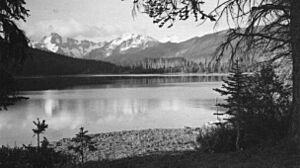Spruce Lake Protected Area facts for kids

The Spruce Lake Protected Area is a huge natural space in British Columbia, Canada. It covers about 71,347 hectares, which is like 176,000 football fields! You can find it about 200 kilometers north of Vancouver. For many years, people argued about how to protect this special area.
This area used to be called the Southern Chilcotin Mountains Provincial Park. People enjoyed hiking, biking, swimming, fishing, and even hunting there. You could also find wild camping spots. Many amazing animals live here, including grizzly bears, California bighorn sheep, and wolverines.
In 2010, a new law called Bill 15 created the South Chilcotin Mountains Park. This new park is a "Class A" park, which means it has the highest level of protection. It covers 56,796 hectares of the original Spruce Lake area. The remaining 14,550 hectares were set aside for things like tourism and mining. However, cutting down trees for logging is still not allowed anywhere in the area.
Protecting a Special Place
This beautiful area was first named a "protected area" by the British Columbia government in 2001. Then, in 2004, it officially became a Provincial Park. This decision was made by Joyce Murray, who was a government minister at the time. The new park included about 70% of the protected area. Some parts on the edges allowed for limited use of natural resources.
The idea to protect this area came from a plan called the Lillooet Land and Resource Management Plan (LRMP). This plan tried to find a balance between what local communities, environmental groups, outdoor lovers, and resource companies wanted. Even though the area isn't exactly in the main Chilcotin District, people started calling it the "South Chilcotins" around 1980. This was when groups began pushing to make it a park. The name "South Chilcotins" comes from its location in the Chilcotin Ranges, which are part of the Bridge River Country where the park is found. A famous naturalist named Bert Brink worked for over sixty years to protect this area. He was able to see it become a park before he passed away in 2007.
Where is Spruce Lake?
The Spruce Lake Protected Area is located on the eastern side of the Pacific Ranges of the Coast Mountains. It sits north of the Bridge River Country and the Chilcotin District to its north. It is next to two other parks: Big Creek Provincial Park and Tsʼilʔos Provincial Park. These parks border it to the north and northwest. The area is part of the larger Chilcotin Ranges. It took about 60 years of discussion and debate before parts of this area were finally protected in the 1990s.
First Nations History
For a long time, this region was a hunting ground for the Lakes Lillooet people, led by Chief Hunter Jack. His business involved hunting big game. They shared the land with hunters from the Tsilhqotʼin people. The shared use of the area north of the Bridge River and Gun Creek was part of a peace agreement. This agreement ended a long and difficult war between Hunter Jack's people and the Tsilhqotʼin.
Old trails from the Bridge River Country crossed this region. They led to Taseko Lake and Chilko Lake in the Chilcotin District. Other trails went east across the Camelsfoot Range to the Fraser River, near a place called Big Bar.

